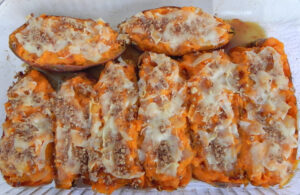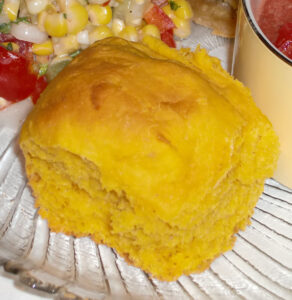 How sweet it is!
How sweet it is!
By Laurie Triplette
ldtriplette@aol.com
SOUTHERNISM OF THE WEEK
Gooder’n grits: It doesn’t get much better than this. Think 2012 Egg Bowl!
ON COOKING SOUTHERN: Sweet Potatoes
According to Wikipedia, (the go-to guide for lazy lookups) what we Southerners know as the sweet potato is Ipomoea batatas, a dicotyledonous plant that belongs to the family Convolvulaceae (morning glory family). This is a large family of more than 1,000 species, many of which are poisonous. The “sweet potato” is actually the large, starchy, sweet-tasting tuberous root of the plant. Thought by scholars to have originated and domesticated at least 5,000 years ago in Central or South America, the sweet potato also was grown in Polynesia before western exploration. Archeologists have identified sweet potato remnants in Peru dating dating back to 8,000 BCE.
Colloquially called yams in some Southern locales, sweet potatoes are smooth-skinned, and are botanically distinct from the genuine “yam,” which is native to Africa and Asia, and which has rough skin and lower nutritional content. The edible sweet potato may range in color from beige and yellow to orange, red, brown, purple. The actual flesh ranges from pale beige to deep orange and purple. The lighter-colored varieties are less sweet and moist than the darker-colored varieties, but adapt readily to savory dishes.
Proven to stabilize insulin blood-sugar levels if consumed unsweetened, the sweet potato is highly nutritious, high in fiber, complex carbohydrates, protein, vitamins A and C, and calcium. The tuber is grown worldwide, with the greatest production in China, New Zealand, the South Pacific, and North America. North Carolina is the largest American producer, followed by California, Louisiana, and Mississippi. The National Sweet Potato Festival is held annually each November in Vardaman, in Calhoun County, MS. And this lowly tuber gave rise to a national “club” of Jackson author Jill Conner Browne’s Sweet Potato Queens, who reign at every Hal and Mal’s St Paddy’s Day Parade in our capitol city.
Until recently, the sweet potato was considered déclassé at some formal tables because of its association with poverty and country living. But with a resurgence of interest in farm-to-table food sourcing and improving citizens’ nutrition, every Southerner’s secret favorite crossover veggie (great for appetizers, main dish sides, AND dessert) has become a culinary star. With good reason! Think Sweet Potato Pie. Candied Sweet Potatoes. Sweet Potato Fries. Sweet Potato Souffle. Sweet Potato Pasta…
RECIPES OF THE WEEK
SWEET POTATO ROLLS
From my cookbook, GIMME SOME SUGAR, DARLIN’, this recipe is best made with fresh mashed tubers. Do not let the dough rise too long or the yeast will taste sour. Fresh-made, unrisen dough may be kept refrigerated up to 3 days if tightly covered with greased plastic wrap. Baked rolls may be frozen. Great bread for ham rolls!
1 pkg active dry yeast (do NOT use Rapid Rise)
1 tsp white granulated sugar
1/4 c lukewarm water
1/2 c white granulated sugar
1/2 c shortening
1 tsp salt
2 c mashed, cooked sweet potato
1 large egg, slightly beaten
4 c all purpose flour, unsifted
 Dissolve yeast and 1 tsp sugar in the warm water in a small bowl. Let stand.
Dissolve yeast and 1 tsp sugar in the warm water in a small bowl. Let stand.
Cover 2 to 4 whole potatoes with water in medium sauce pan. Boil until fork tender, about 1 hour. Remove from water, peel off skins, mash potato flesh. Measure out 2 c of mash. Mix the sugar, shortening, and salt into hot mashed potatoes in large bowl. Let mixture cool to lukewarm, stir in the yeast and egg. Work in flour. Dough should be slightly stiff when all has been added. Cover with a dampened cloth and let rise in a warm place until dough doubles in size, about 1 to 1-1/2 hour.
Grease a 9-by-13-inch pan. Mash down risen dough; pinch off and loosely roll into 2-inch balls. Place each roll into prepared pan with sides almost touching. Let rise, covered with damp cloth, until double in bulk (about 1 hour). Bake rolls in preheated oven at 375˚F for 20-30 minutes on rack farthest from heat (bottoms burn easily). Yield: 20-24 rolls.
TWICE BAKED SAVORY SWEET POTATOES
One may create our traditional holiday dish by combining cooked potato puree with butter, brown sugar or maple syrup, cinnamon, nutmeg, orange juice, and marshmallows. But try this version as a savory foil for your next holiday turkey.
4 large sweet potatoes
3 T extra light olive oil, plus more for cooking
Kosher salt
1 large yellow onion
4 slices crisp-cooked bacon, crumbled (1 slice= 1 T)
3 T butter or butter substitute
3 T sour cream (may substitute crème fraiche)
Salt and pepper to taste (be sparing)
2 tsp fresh lemon zest
1/2 c sharp Cheddar cheese, shredded
2 to 3 oz shaved Parmesan
1 to 2 T fine-chopped pecans, roasted and salted
Preheat oven to 400˚F. Select relatively smooth large-sized tubers, more oblong than rounded. Scrub clean and pat dry. Puncture once with paring knife to allow steam to escape while baking. Lightly rub all over with olive oil and sprinkle with Kosher salt. Place on cookie sheet and bake 30-45 minutes, until soft but not falling apart.
Slice onion into rounds about 1/4-inch thick; cut each round into eight wedges like a pie. Heat 2 T olive oil on medium-high heat in skillet. Add onions, stirring, until transparent and browned. Set aside. Cook bacon either in skillet or microwave until crisp. Drain and crumble. NOTE: May substitute 4 T of jarred real bacon bits.
Remove baked potatoes from oven. Let cool enough to handle. Slice in half lengthwise. Scoop out hot potato pulp, but leave enough remaining against the skins to maintain “shell” shape. Mix potato pulp, butter, sour cream, salt, and pepper until smooth. Stir in Cheddar, bacon, and onions. Spoon potato mixture back into skins placed in 9-by-13-inch glass pan (positioned 6 across and two below). (May refrigerate at this point until ready to finish.) Sprinkle first with Parmesan, then dust with chopped pecans. Bake at 375˚F for 10-15 minutes, or until cheese melts. YIELD: 8 servings.

